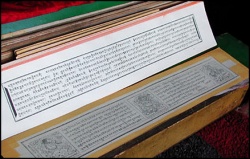Why Are Tibetan Books Rectangular in Shape?
Tibetan books are printed by woodblock, and whether they are Buddhist scriptures or books on astronomy and calendaring, they are also rectangular in shape. Compared to books printed by other ethnic groups in China, this is obviously a unique style. Here are three reasons for this.
Reason I: During the Tubo Kingdom period in the 7th century, Buddhism spread from India to the Tibetan-inhabited areas. Monks hailing from India and Nepal brought pattra-leaf sutras to Tubo. The fact that pattra leaves are wide posed carrying difficulties on long journeys, so they were cut into "bars", which were bound together and covered with a board. This enabled them to be carried on the back during the trek across the mountains.
Reason II: Lang Darma, the last king of the Tubo Kingdom, thought Buddhism was the root cause of poverty in Tubo and ordered the destruction of all the monasteries. Lamas were forced to resume secular life, and books were confiscated. While being forced to go hunting in the mountains, an act going against the Buddhist tenet of not killing any living being, the lamas managed to hide books in long sleeves of their robes for reading in the deep mountains. This prompted the printing of rectangular sutra books in later times.
Reason III: Birches, each with a diameter of 10 cm, were used for woodblock printing. This is why rectangular books were always produced. As a token of respect for Tibetan tradition, even with modern printing means, books retain their rectangular shape.
